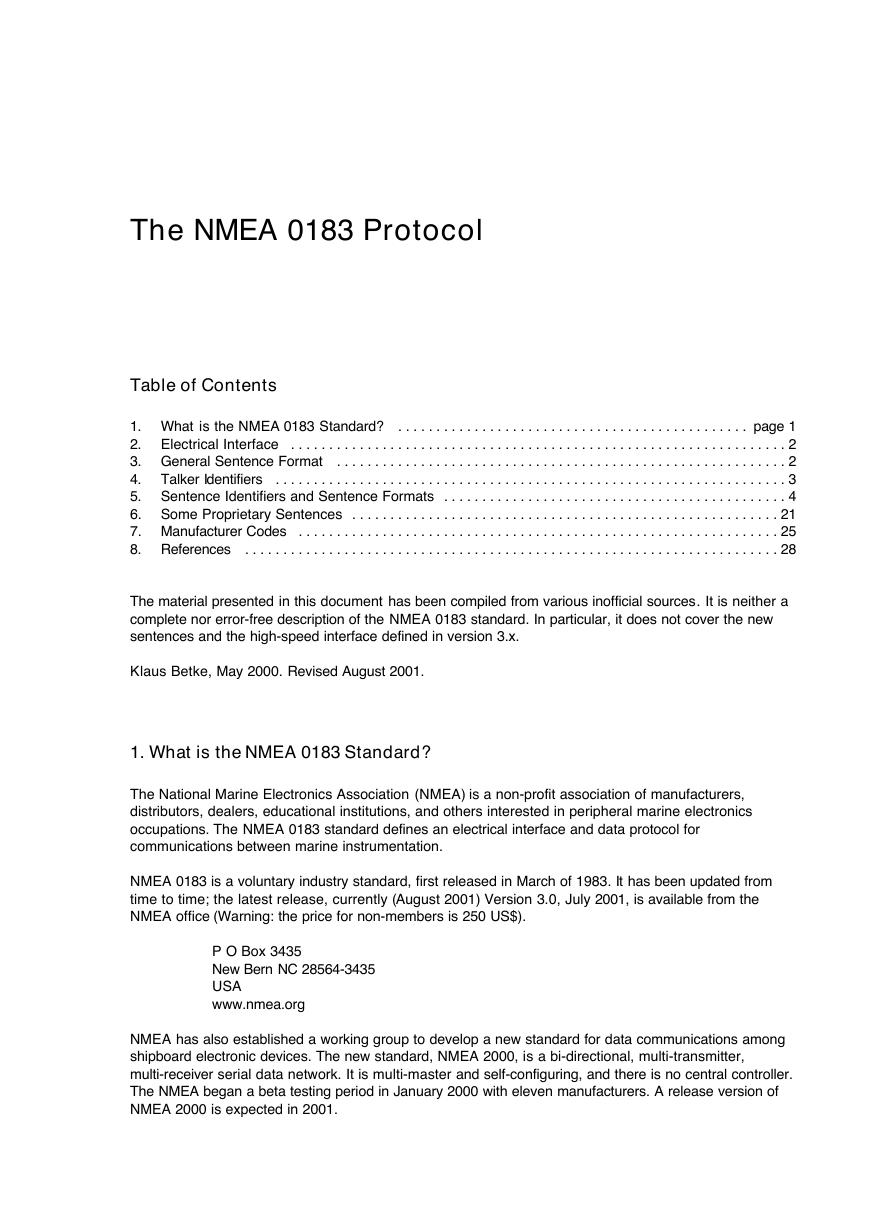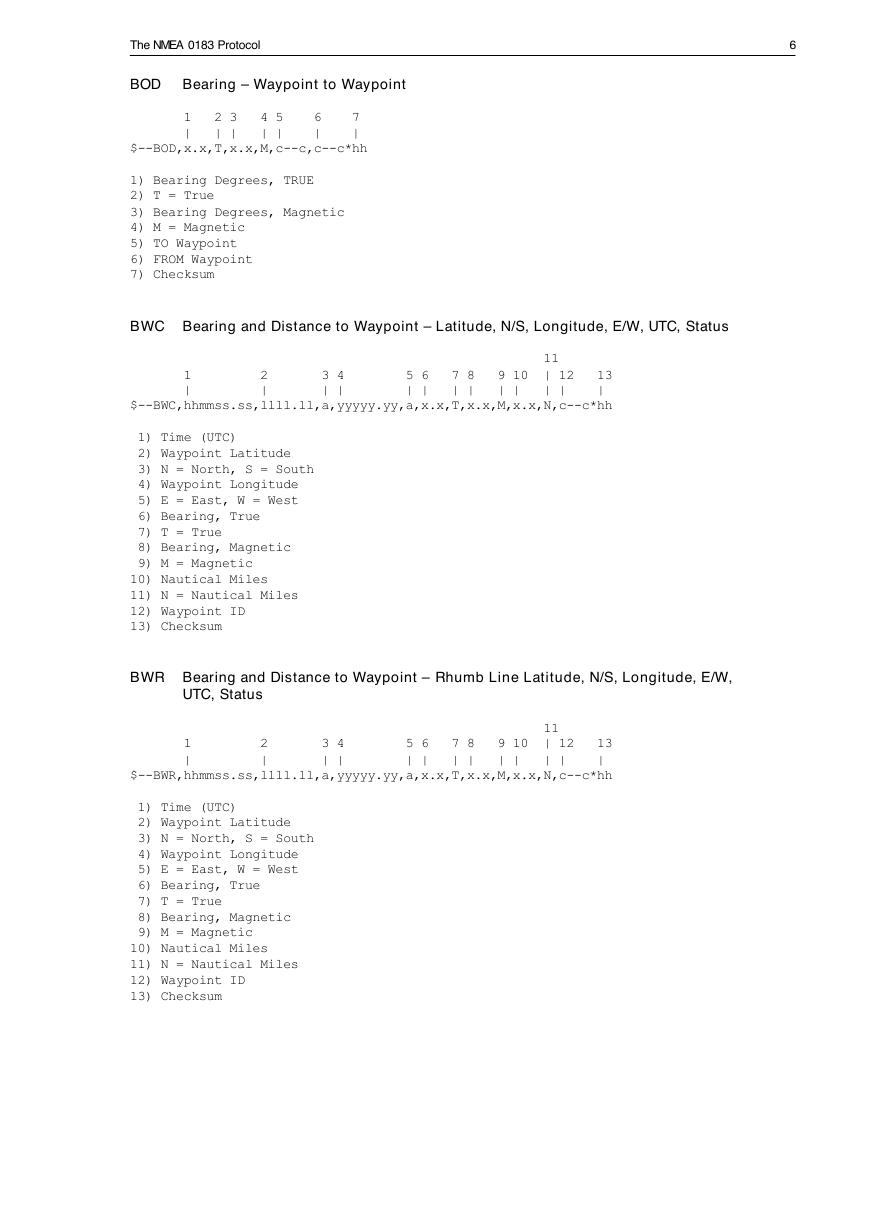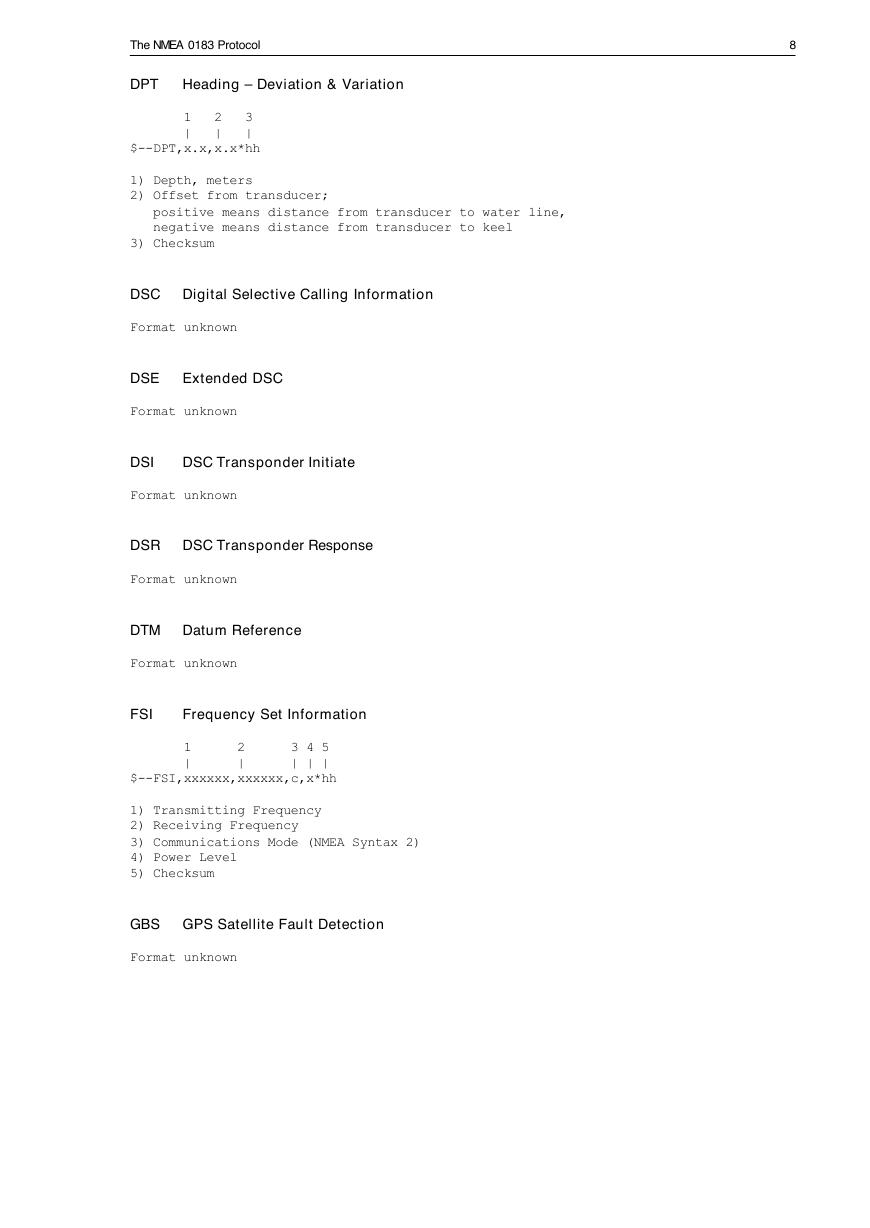The NMEA 0183 Protocol
Table of Contents
1. What is the NMEA 0183 Standard? . . . . . . . . . . . . . . . . . . . . . . . . . . . . . . . . . . . . . . . . . . . . . . page 1
Electrical Interface . . . . . . . . . . . . . . . . . . . . . . . . . . . . . . . . . . . . . . . . . . . . . . . . . . . . . . . . . . . . . . . . . 2
2.
3. General Sentence Format
. . . . . . . . . . . . . . . . . . . . . . . . . . . . . . . . . . . . . . . . . . . . . . . . . . . . . . . . . . . 2
Talker Identifiers . . . . . . . . . . . . . . . . . . . . . . . . . . . . . . . . . . . . . . . . . . . . . . . . . . . . . . . . . . . . . . . . . . . 3
4.
Sentence Identifiers and Sentence Formats . . . . . . . . . . . . . . . . . . . . . . . . . . . . . . . . . . . . . . . . . . . . . 4
5.
6.
Some Proprietary Sentences . . . . . . . . . . . . . . . . . . . . . . . . . . . . . . . . . . . . . . . . . . . . . . . . . . . . . . . . 21
7. Manufacturer Codes . . . . . . . . . . . . . . . . . . . . . . . . . . . . . . . . . . . . . . . . . . . . . . . . . . . . . . . . . . . . . . . 25
8. References . . . . . . . . . . . . . . . . . . . . . . . . . . . . . . . . . . . . . . . . . . . . . . . . . . . . . . . . . . . . . . . . . . . . . . 28
The material presented in this document has been compiled from various inofficial sources. It is neither a
complete nor error-free description of the NMEA 0183 standard. In particular, it does not cover the new
sentences and the high-speed interface defined in version 3.x.
Klaus Betke, May 2000. Revised August 2001.
1. What is the NMEA 0183 Standard?
The National Marine Electronics Association (NMEA) is a non-profit association of manufacturers,
distributors, dealers, educational institutions, and others interested in peripheral marine electronics
occupations. The NMEA 0183 standard defines an electrical interface and data protocol for
communications between marine instrumentation.
NMEA 0183 is a voluntary industry standard, first released in March of 1983. It has been updated from
time to time; the latest release, currently (August 2001) Version 3.0, July 2001, is available from the
NMEA office (Warning: the price for non-members is 250 US$).
P O Box 3435
New Bern NC 28564-3435
USA
www.nmea.org
NMEA has also established a working group to develop a new standard for data communications among
shipboard electronic devices. The new standard, NMEA 2000, is a bi-directional, multi-transmitter,
multi-receiver serial data network. It is multi-master and self-configuring, and there is no central controller.
The NMEA began a beta testing period in January 2000 with eleven manufacturers. A release version of
NMEA 2000 is expected in 2001.
�
The NMEA 0183 Protocol
2. Electrical Interface
2
NMEA 0183 devices are designated as either talkers or listeners (with some devices being both),
employing an asynchronous serial interface with the following parameters:
Baud rate:
Number of data bits:
Stop bits:
Parity:
Handshake:
4800
8 (bit 7 is 0)
1 (or more)
none
none
NMEA 0183 allows a single talker and several listeners on one circuit. The recommended interconnect
wiring is a shielded twisted pair, with the shield grounded only at the talker. The standard dos not specify
the use of a particular connector. Note: The new 0183-HS standard (HS = high speed) introduced in
version 3.0 uses a 3-wire interface and a baud rate of 38400. This type of interface is not discussed here.
Its is recommended that the talker output comply with EIA RS-422, a differential system with two signal
lines, "A" and "B". Differential drive signals have no reference to ground and are more immune to noise.
However, a single-ended line at TTL level is accepted as well. The voltages on the A line correspond to
those on the TTL single wire, while the B voltages are inverted (when output A is at +5 V, output B is at
0 V, and vice versa. This is the unipolar RS-422 operation. In bipolar mode ±5 V are used).
In either case, the recommended receive circuit uses an opto-isolator with suitable protection circuitry.
The input should be isolated from the receiver's ground. In practice, the single wire, or the RS-422 "A"
wire may be directly connected to a computer's RS-232 input. In fact even many of the latest products,
like hand-held GPS receivers, do not have a RS-422 differential output, but just a single line with TTL or
5 V CMOS compatible signal level.
3. General Sentence Format
All data is transmitted in the form of sentences. Only printable ASCII characters are allowed, plus CR
(carriage return) and LF (line feed). Each sentence starts with a "$" sign and ends with . There
are three basic kinds of sentences: talker sentences, proprietary sentences and query sentences.
Talker Sentences. The general format for a talker sentence is:
$ttsss,d1,d2,....
The first two letters following the „$” are the talker identifier. The next three characters (sss) are the
sentence identifier, followed by a number of data fields separated by commas, followed by an optional
checksum, and terminated by carriage return/line feed. The data fields are uniquely defined for each
sentence type. An example talker sentence is:
$HCHDM,238,M
where "HC" specifies the talker as being a magnetic compass, the "HDM" specifies the magnetic heading
message follows. The "238" is the heading value, and "M" designates the heading value as magnetic.
A sentence may contain up to 80 characters plus "$" and CR/LF. If data for a field is not available, the
field is omitted, but the delimiting commas are still sent, with no space between them. The checksum
field consists of a "*" and two hex digits representing the exclusive OR of all characters between, but not
including, the "$" and "*".
Proprietary Sentences. The standard allows individual manufacturers to define proprietary sentence
formats. These sentences start with "$P", then a 3 letter manufacturer ID, followed by whatever data the
manufacturer wishes, following the general format of the standard sentences. Some proprietary
sentences, mainly from Garmin, Inc., are listed in chapter 6.
�
The NMEA 0183 Protocol
3
Query sentences. A query sentence is a means for a listener to request a particular sentence from a
talker. The general format is:
$ttllQ,sss,[CR][LF]
The first two characters of the address field are the talker identifier of the requester and the next two
characters are the talker identifier of the device being queried (listener). The fifth character is always a "Q"
defining the message as a query. The next field (sss) contains the three letter mnemonic of the sentence
being requested. An example query sentence is:
$CCGPQ,GGA
where the "CC" device (computer) is requesting from the "GP" device (a GPS unit) the "GGA" sentence.
The GPS will then transmit this sentence once per second until a different query is requested.
4. Talker Identifiers
Autopilot - General
Autopilot - Magnetic
Communications – Digital Selective Calling (DSC)
Communications – Receiver / Beacon Receiver
Communications – Satellite
Communications – Radio-Telephone (MF/HF)
Communications – Radio-Telephone (VHF)
Communications – Scanning Receiver
Direction Finder
Electronic Chart Display & Information System (ECDIS)
Emergency Position Indicating Beacon (EPIRB)
Engine Room Monitoring Systems
Global Positioning System (GPS)
Heading – Magnetic Compass
Heading – North Seeking Gyro
AG
AP
CD
CR
CS
CT
CV
CX
DF
EC
EP
ER
GP
HC
HE
HN Heading – Non North Seeking Gyro
II
IN
LC
P
RA
SD
SN
SS
TI
VD
DM
VW
WI
YX
ZA
ZC
ZQ
ZV
Integrated Instrumentation
Integrated Navigation
Loran C
Proprietary Code
RADAR and/or ARPA
Sounder, Depth
Electronic Positioning System, other/general
Sounder, Scanning
Turn Rate Indicator
Velocity Sensor, Doppler, other/general
Velocity Sensor, Speed Log, Water, Magnetic
Velocity Sensor, Speed Log, Water, Mechanical
Weather Instruments
Transducer
Timekeeper – Atomic Clock
Timekeeper – Chronometer
Timekeeper – Quartz
Timekeeper – Radio Update, WWV or WWVH
�
The NMEA 0183 Protocol
4
5. Sentence Identifiers and Formats
AAM Waypoint Arrival Alarm
1 2 3 4 5 6
| | | | | |
$--AAM,A,A,x.x,N,c--c*hh
1) Status, BOOLEAN, A = Arrival circle entered
2) Status, BOOLEAN, A = perpendicular passed at waypoint
3) Arrival circle radius
4) Units of radius, nautical miles
5) Waypoint ID
6) Checksum
ALM GPS Almanac Data
1 2 3 4 5 6 7 8 9 10 11 12 13 14 15 16
| | | | | | | | | | | | | | | |
$--ALM,x.x,x.x,xx,x.x,hh,hhhh,hh,hhhh,hhhh,hhhhhh,hhhhhh,hhhhhh,hhhhhh,hhh,hhh,*hh
1) Total number of messages
2) Message Number
3) Satellite PRN number (01 to 32)
4) GPS Week Number: Date and time in GPS is computed as number of weeks
from 6 January 1980 plus number of seconds into the week.
5) SV health, bits 17-24 of each almanac page
6) Eccentricity
7) Almanac Reference Time
8) Inclination Angle
9) Rate of Right Ascension
10) Root of semi-major axis
11) Argument of perigee
12) Longitude of ascension node
13) Mean anomaly
14) F0 Clock Parameter
15) F1 Clock Parameter
16) Checksum
APA Autopilot Sentence "A"
1 2 3 4 5 6 7 8 9 10 11
| | | | | | | | | | |
$--APA,A,A,x.xx,L,N,A,A,xxx,M,c---c*hh
1) Status
V = LORAN-C Blink or SNR warning
A = general warning flag or other navigation systems when a reliable
fix is not available
2) Status
V = Loran-C Cycle Lock warning flag
A = OK or not used
3) Cross Track Error Magnitude
4) Direction to steer, L or R
5) Cross Track Units (Nautic miles or kilometres)
6) Status
A = Arrival Circle Entered
7) Status
A = Perpendicular passed at waypoint
8) Bearing origin to destination
9) M = Magnetic, T = True
10) Destination Waypoint ID
11) checksum
�
The NMEA 0183 Protocol
5
Autopilot Sentence "B"
APB
13 15
1 2 3 4 5 6 7 8 9 10 11 12| 14|
| | | | | | | | | | | | | | |
$--APB,A,A,x.x,a,N,A,A,x.x,a,c--c,x.x,a,x.x,a*hh
1) Status
V = LORAN-C Blink or SNR warning
A = general warning flag or other navigation systems when a reliable
fix is not available
2) Status
V = Loran-C Cycle Lock warning flag
A = OK or not used
3) Cross Track Error Magnitude
4) Direction to steer, L or R
5) Cross Track Units, N = Nautical Miles
6) Status
A = Arrival Circle Entered
7) Status
A = Perpendicular passed at waypoint
8) Bearing origin to destination
9) M = Magnetic, T = True
10) Destination Waypoint ID
11) Bearing, present position to Destination
12) M = Magnetic, T = True
13) Heading to steer to destination waypoint
14) M = Magnetic, T = True
15) Checksum
ASD
Autopilot System Data
Format unknown
Bearing & Distance to Waypoint – Dead Reckoning
BEC
12
1 2 3 4 5 6 7 8 9 10 11| 13
| | | | | | | | | | | | |
$--BEC,hhmmss.ss,llll.ll,a,yyyyy.yy,a,x.x,T,x.x,M,x.x,N,c--c*hh
1) Time (UTC)
2) Waypoint Latitude
3) N = North, S = South
4) Waypoint Longitude
5) E = East, W = West
6) Bearing, True
7) T = True
8) Bearing, Magnetic
9) M = Magnetic
10) Nautical Miles
11) N = Nautical Miles
12) Waypoint ID
13) Checksum
�
The NMEA 0183 Protocol
6
BOD
Bearing – Waypoint to Waypoint
1 2 3 4 5 6 7
| | | | | | |
$--BOD,x.x,T,x.x,M,c--c,c--c*hh
1) Bearing Degrees, TRUE
2) T = True
3) Bearing Degrees, Magnetic
4) M = Magnetic
5) TO Waypoint
6) FROM Waypoint
7) Checksum
BWC Bearing and Distance to Waypoint – Latitude, N/S, Longitude, E/W, UTC, Status
11
1 2 3 4 5 6 7 8 9 10 | 12 13
| | | | | | | | | | | | |
$--BWC,hhmmss.ss,llll.ll,a,yyyyy.yy,a,x.x,T,x.x,M,x.x,N,c--c*hh
1) Time (UTC)
2) Waypoint Latitude
3) N = North, S = South
4) Waypoint Longitude
5) E = East, W = West
6) Bearing, True
7) T = True
8) Bearing, Magnetic
9) M = Magnetic
10) Nautical Miles
11) N = Nautical Miles
12) Waypoint ID
13) Checksum
BWR Bearing and Distance to Waypoint – Rhumb Line Latitude, N/S, Longitude, E/W,
UTC, Status
11
1 2 3 4 5 6 7 8 9 10 | 12 13
| | | | | | | | | | | | |
$--BWR,hhmmss.ss,llll.ll,a,yyyyy.yy,a,x.x,T,x.x,M,x.x,N,c--c*hh
1) Time (UTC)
2) Waypoint Latitude
3) N = North, S = South
4) Waypoint Longitude
5) E = East, W = West
6) Bearing, True
7) T = True
8) Bearing, Magnetic
9) M = Magnetic
10) Nautical Miles
11) N = Nautical Miles
12) Waypoint ID
13) Checksum
�
The NMEA 0183 Protocol
7
BWW Bearing – Waypoint to Waypoint
1 2 3 4 5 6 7
| | | | | | |
$--BWW,x.x,T,x.x,M,c--c,c--c*hh
1) Bearing Degrees, TRUE
2) T = True
3) Bearing Degrees, Magnetic
4) M = Magnetic
5) TO Waypoint
6) FROM Waypoint
7) Checksum
DBK
Depth Below Keel
1 2 3 4 5 6 7
| | | | | | |
$--DBK,x.x,f,x.x,M,x.x,F*hh
1) Depth, feet
2) f = feet
3) Depth, meters
4) M = meters
5) Depth, Fathoms
6) F = Fathoms
7) Checksum
DBS
Depth Below Surface
1 2 3 4 5 6 7
| | | | | | |
$--DBS,x.x,f,x.x,M,x.x,F*hh
1) Depth, feet
2) f = feet
3) Depth, meters
4) M = meters
5) Depth, Fathoms
6) F = Fathoms
7) Checksum
DBT
Depth Below Transducer
1 2 3 4 5 6 7
| | | | | | |
$--DBT,x.x,f,x.x,M,x.x,F*hh
1) Depth, feet
2) f = feet
3) Depth, meters
4) M = meters
5) Depth, Fathoms
6) F = Fathoms
7) Checksum
DCN
Decca Position
obsolete
�
The NMEA 0183 Protocol
8
DPT
Heading – Deviation & Variation
1 2 3
| | |
$--DPT,x.x,x.x*hh
1) Depth, meters
2) Offset from transducer;
positive means distance from transducer to water line,
negative means distance from transducer to keel
3) Checksum
DSC
Digital Selective Calling Information
Format unknown
DSE
Extended DSC
Format unknown
DSI
DSC Transponder Initiate
Format unknown
DSR
DSC Transponder Response
Format unknown
DTM Datum Reference
Format unknown
FSI
Frequency Set Information
1 2 3 4 5
| | | | |
$--FSI,xxxxxx,xxxxxx,c,x*hh
1) Transmitting Frequency
2) Receiving Frequency
3) Communications Mode (NMEA Syntax 2)
4) Power Level
5) Checksum
GBS
GPS Satellite Fault Detection
Format unknown
�
















 V2版本原理图(Capacitive-Fingerprint-Reader-Schematic_V2).pdf
V2版本原理图(Capacitive-Fingerprint-Reader-Schematic_V2).pdf 摄像头工作原理.doc
摄像头工作原理.doc VL53L0X简要说明(En.FLVL53L00216).pdf
VL53L0X简要说明(En.FLVL53L00216).pdf 原理图(DVK720-Schematic).pdf
原理图(DVK720-Schematic).pdf 原理图(Pico-Clock-Green-Schdoc).pdf
原理图(Pico-Clock-Green-Schdoc).pdf 原理图(RS485-CAN-HAT-B-schematic).pdf
原理图(RS485-CAN-HAT-B-schematic).pdf File:SIM7500_SIM7600_SIM7800 Series_SSL_Application Note_V2.00.pdf
File:SIM7500_SIM7600_SIM7800 Series_SSL_Application Note_V2.00.pdf ADS1263(Ads1262).pdf
ADS1263(Ads1262).pdf 原理图(Open429Z-D-Schematic).pdf
原理图(Open429Z-D-Schematic).pdf 用户手册(Capacitive_Fingerprint_Reader_User_Manual_CN).pdf
用户手册(Capacitive_Fingerprint_Reader_User_Manual_CN).pdf CY7C68013A(英文版)(CY7C68013A).pdf
CY7C68013A(英文版)(CY7C68013A).pdf TechnicalReference_Dem.pdf
TechnicalReference_Dem.pdf